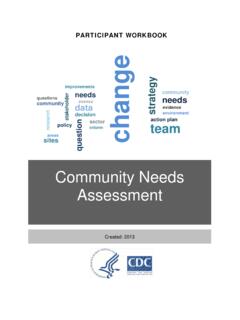Transcription of Children & neurodevelopmental disorders
1 1 Children AND Children AND neurodevelopmental BEHAVIOURAL neurodevelopmental BEHAVIOURAL INTELLECTUAL disorders (NDBID)INTELLECTUAL disorders (NDBID)TRAINING FOR THE HEALTH SECTORTRAINING FOR THE HEALTH SECTOR[Date [Date ..Place Place .. ]Organizer] Children 's Health and the EnvironmentWHO Training Package for the Health SectorWorld Health 2011<<NOTE TO USER: Please add details of the date, time, place and sponsorship of the meeting for which you are using this presentation in the space indicated.>> <<NOTE TO USER: This is a large set of slides from which the presenter should select the most relevant ones to use in a specific presentation. These slides cover many facets of the problem. Present only those slides that apply most directly to the local situation in the region.
2 >> <<NOTE TO USER: This module presents several examples of risk factors that affect neurodevelopment, you can find more detailed information in other modules of the training package that deal with specific risk factors, such as lead, mercury, pesticides, persistent organic pollutants, endocrine disruptors; or prenatal exposures and developmental effects.>>2 Children & Children & neurodevelopmentalneurodevelopmentalbeha vioural intellectual disordersbehavioural intellectual disordersOBJECTIVESOBJECTIVES To define & describe common neurodevelopmental Behavioral Intellectual disorders (NDBID) and their prevalence. To understand the neurodevelopmental process in the context of basic science and environmental data.
3 To discuss key epidemiological studies addressing environmental risk factors. To gain insight into environmental neurotoxic potential exposures and complexities of attributing causality.<<READ SLIDE>>3 Children & Children & neurodevelopmentalneurodevelopmentalbeha vioural intellectual disordersbehavioural intellectual disordersOVERVIEWOVERVIEW Descriptions of common neurodevelopmental Behavioral Intellectual disorders (NDBID). Brief epidemiology of neurodevelopmental Behavioral Intellectual disorders . Summary of neurodevelopmental processes. Discussion of environmental linkages. Impacts of neurodevelopmental Behavioral Intellectual disorders and challenges of adequately protecting Children .<<READ SLIDE>>4 Children & Children & neurodevelopmentalneurodevelopmentalbeha vioural intellectual disordersbehavioural intellectual disordersMoore, Elsevier Inc, 1973 WINDOWS OF DEVELOPMENTWINDOWS OF DEVELOPMENTP hysiological differences between Children and adults are not only manifest in immature metabolic pathways.
4 Because important systems are still differentiating and growing, Children have unique susceptibilities not seen in adults and critical time windows for those susceptibilities. The critical times are as follows: preconception gestation (susceptibility to: thalidomide, DES, ionizing radiation, methylmercury, lead) postnatal (susceptibility to: SHTS ( second -hand tobacco smoke ), has been an explosion of knowledge about child development in past decade or so, and it is hard to remember that it was only about 50 years ago that the discovery was made that the fetus is vulnerable to exposures. The phocomelia epidemic resulting from use of thalidomide by pregnant women was an early and dramatic example of the ability of chemicals to traverse the placenta and damage the fetus.)
5 Additionally, thalidomide administered during a small, 4-day window between gestational days 20 and 24, may increase the risk of autism (Stromland, 1994).More than one system can be susceptible and different pathology may occur depending upon the dose and timing of exposure. Now we know that other exposures during gestation, some of which are listed here, can harm the systems of the developing child. We also know that preconception exposure of parents, as well as postnatal exposure of both parents, can harm Children . <<NOTES TO USER: It is important to point out the different responses to insults shown on the bottom bar of the figure. Significant insult during the embryonic phase will result in pregnancy loss (first 2 weeks) or major organ malformation.
6 During the fetal stage, damage is more subtle and related to system dysfunction.>>Ref: Stromland. Autism in thalidomide embryopathy: a population Medicine & Child Neurology, 1994, 36 a population of 100 Swedish thalidomide embryopathy cases, at least four met full criteria for DSM-III-R autistic disorder and ICD-10 childhood autism. Thalidomide embryopathy of the kind encountered in these cases affects fetal development early in pregnancy, probably on days 20 to 24 after conception. It is argued that the possible association of thalidomide embryopathy with autism may shed some light on the issue of which neural circuitries may be involved in autism : Reprinted from developing human. Elsevier Inc., with copyright permission (2004) from & Children & neurodevelopmentalneurodevelopmentalbeha vioural intellectual disordersbehavioural intellectual disordersNEURODEVELOPMENTAL PROCESSESNEURODEVELOPMENTAL PROCESSESRice D.
7 Environ Health Perspectives, 2000;108(S3)Neurodevelopment begins in the early prenatal stage with a complex neurological development that begins with proliferation of radial glia and neurons. These continue to develop in the postnatal years. This process is not complete until almost 3 years of age. Migration of neurons, which occurs from the 2nd to the 6th month of gestation, and again within the cerebellum postnatally, is a very important and complex process. Synapse formation, which occurs essentially in the last trimester as well as in the first 2 years of life, is critical to ongoing functioning and development. Myelination is an important process that begins in the second half of gestation and goes on to adolescence, with different systems myelinating at different times, as shown in the : Rice D, Barone Jr S.
8 Critical periods of vulnerability for the developing nervous system: evidence from humans and animal models. Environmental Health Perspectives, 2000, 108(S3):511-533. 6 Children & Children & neurodevelopmentalneurodevelopmentalbeha vioural intellectual disordersbehavioural intellectual disordersCortex maturation from ages 5 to 20 years: synaptic pruning of unused neural connections Abnormalities in maturation may underlie neurodevelopmental disorders Increased pruning with childhood-onset schizophrenia; decreased with autismNEURODEVELOPMENTAL PROCESSESNEURODEVELOPMENTAL PROCESSESRefs: Gogtay N et al. From the Cover: Dynamic mapping of human cortical development during childhood through early adulthood. Proceedings of the National Academy of Sciences, 2004, 101: 8174-8179 National Institute of Mental Health (NIMH) / University of California Los Angeles (UCLA).
9 Time-lapse imaging tracks brain developing from ages 5 to 20. NIMH/UCLA Project visualizes maturing brain - available at ~thompson/ accessed 15 June 2011 The brain's center of reasoning and problem solving is among the last to mature. The decade-long magnetic resonance imaging (MRI) study of normal brain development, from ages 4 to 21, by researchers at NIH's National Institute of Mental Health (NIMH) and University of California Los Angeles (UCLA) shows that such "higher-order" brain centers, such as the prefrontal cortex, don't fully develop until young adulthood. A time-lapse 3-D movie that compresses 15 years of human brain maturation, ages 5 to 20, into seconds shows gray matter - the working tissue of the brain's cortex - diminishing in a back-to-front wave, likely reflecting the pruning of unused neuronal connections during the teen years.
10 Cortex areas can be seen maturing at ages in which relevant cognitive and functional developmental milestones researchers scanned the same 13 healthy Children and teens every two years as they grew up, for 10 years. After co-registering the scans with each other, using an intricate set of brain anatomical landmarks, they visualized the ebb and flow of gray matter - neurons and their branch-like extensions - in maps that, together, form the movie showing brain maturation from ages 5 to 20. It was long believed that a spurt of overproduction of gray matter during the first 18 months of life was followed by a steady decline as unused circuitry is discarded. Then, in the late 1990s, NIMH's Dr. Jay Giedd, a co-author of the current study, and colleagues, discovered a second wave of overproduction of gray matter just prior to puberty, followed by a second bout of "use-it-or-lose-it" pruning during the teen years.















